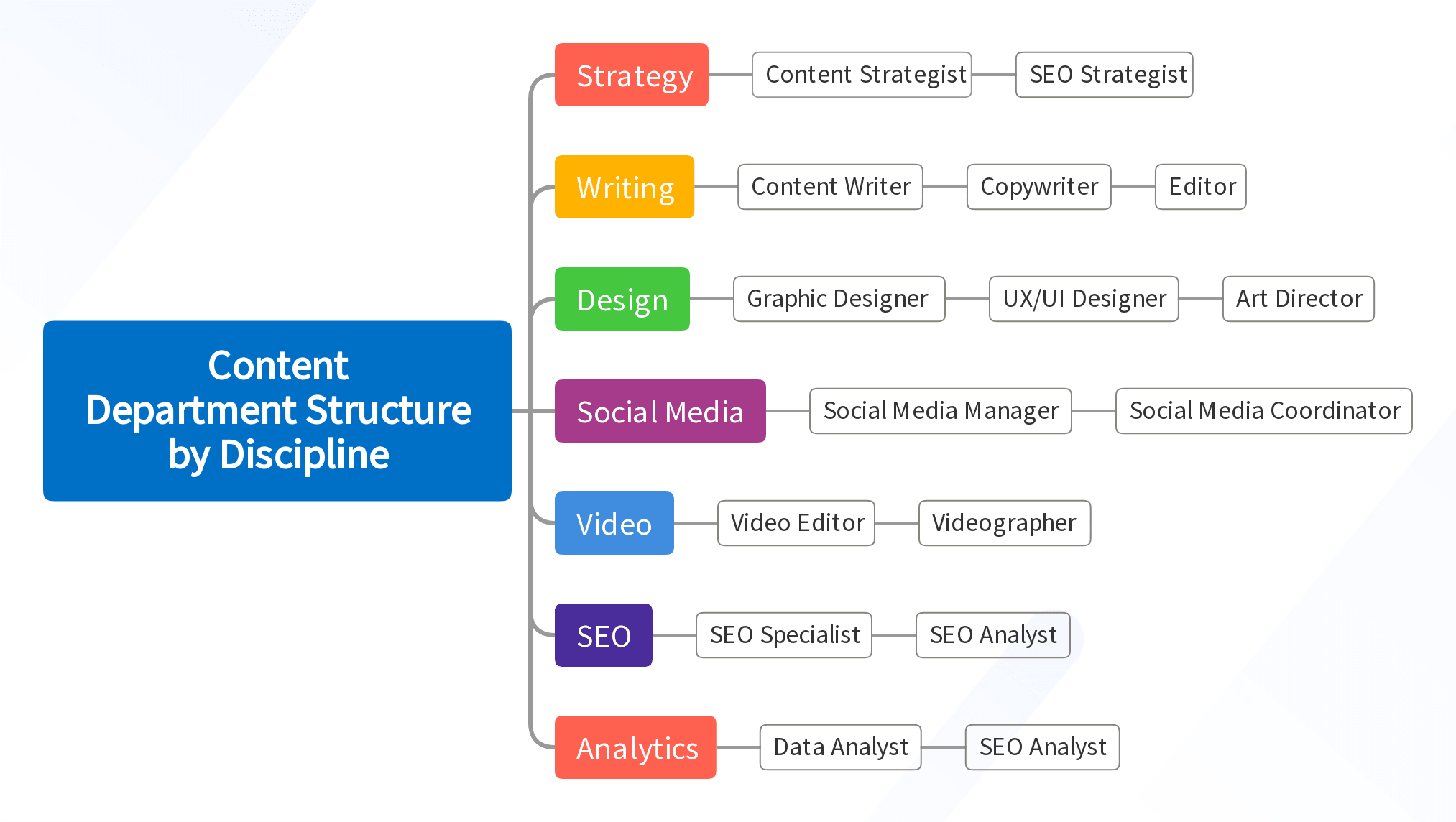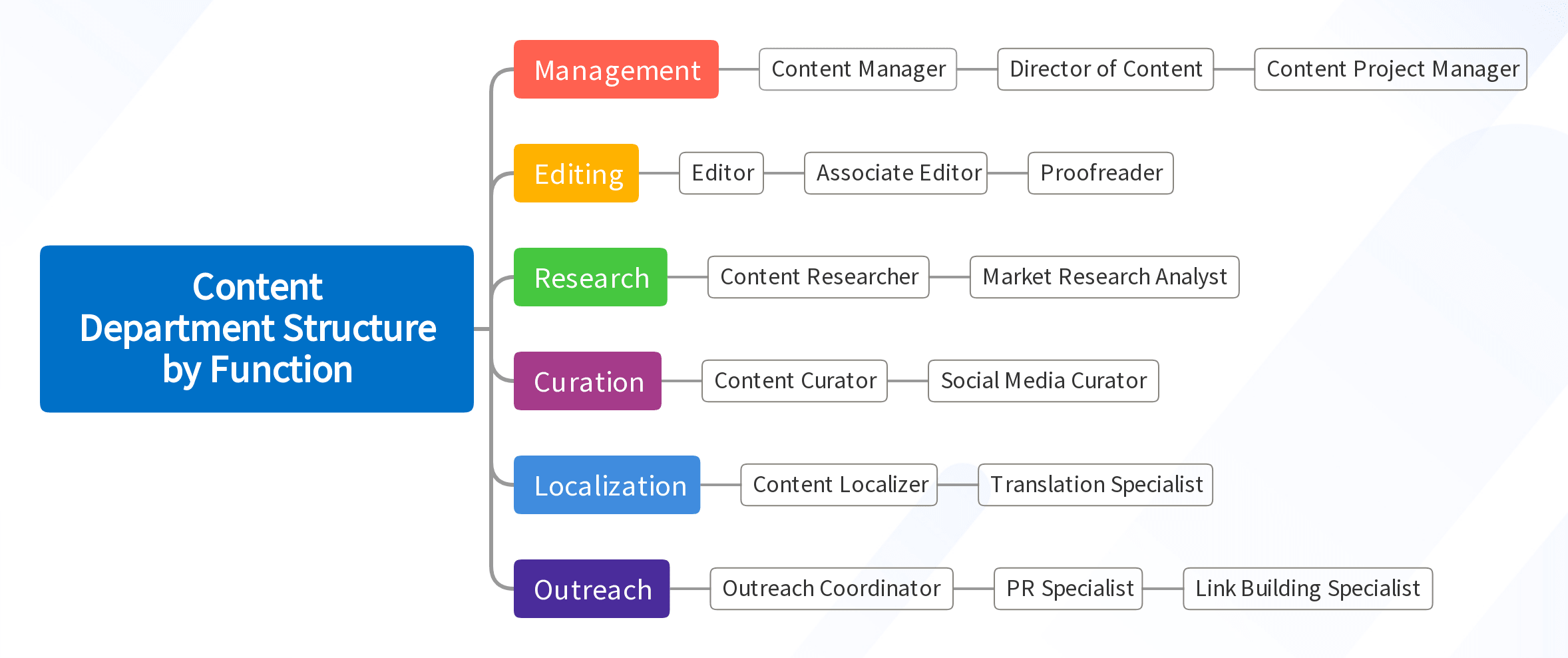

Content teams are the backbone of today's evolving business world. They craft messages that resonate, building bridges between businesses and their audience.
Understanding the structure of such teams is crucial. It's a blend of art, science, and management, working in unison to deliver impactful content. We've learned this firsthand while growing our own marketing agency, GrantSpark.
But first, let's talk about the Content department structures you have to choose from.
Best for Growth Marketers
Best for Paid Ads & CMO's
Table of Contents
Structuring Content Department
There are two main types of department structures based on company size and resources.
- Content department structure by discipline
- Org Type: Traditional corporate departments
- Best For: Midsize/Enterprise companies
- Content department structure by function
- Org Type: Employees are grouped by activities and objectives
- Best For: Small to Medium Sized Business (SMB)
Let’s go in-depth to each one of them.
1. Content Department Structure by Discipline


Discipline-based structure involves building teams centered around various marketing disciplines. For example, SEO, Content, Market Research, and Product Strategy could each form separate teams within a department.
| Discipline | Key Skills | Potential Roles |
|---|---|---|
| Strategy | Content planning, SEO knowledge, Market research, Analytical thinking, Creativity | Content Strategist, SEO Strategist |
| Writing | Writing and editing, Storytelling, Grammar proficiency, Research, SEO writing | Content Writer, Copywriter, Editor |
| Design | Graphic design, UX/UI design, Creativity, Attention to detail, Software proficiency | Graphic Designer, UX/UI Designer, Art Director |
| Social Media | Social media management, Content creation, Trend awareness, Creativity, Communication | Social Media Manager, Social Media Coordinator |
| Video | Video editing, Storyboarding, Creativity, Camera operation, Post-production | Video Editor, Videographer |
| SEO | Keyword research, SEO tools, Analytics, On-page and Off-page SEO, Technical SEO | SEO Specialist, SEO Analyst |
| Analytics | Data analysis, SEO knowledge, Excel proficiency, Critical thinking, Reporting | Data Analyst, SEO Analyst |
2. Content Department Structure by Function


Another approach is structuring by function, where teams are formed based on the different functions they perform. For example, promotion, launches, and relationship management could all be separate teams.
| Function | Key Skills | Potential Roles |
|---|---|---|
| Management | Leadership, Project management, Budgeting, Communication, Decision-making | Content Manager, Director of Content, Content Project Manager |
| Editing | Proofreading, Copy editing, Content review, Attention to detail, SEO knowledge | Editor, Associate Editor, Proofreader |
| Research | Market research, Data analysis, Trend awareness, Detail-oriented, Critical thinking | Content Researcher, Market Research Analyst |
| Curation | Content selection, Trend spotting, Creativity, Knowledge of audience, SEO knowledge | Content Curator, Social Media Curator |
| Localization | Translation, Cultural understanding, Attention to detail, Language proficiency, SEO knowledge | Content Localizer, Translation Specialist |
| Outreach | Networking, Communication, Relationship building, SEO knowledge, Social media proficiency | Outreach Coordinator, PR Specialist, Link Building Specialist |
Content Team Size versus Business Scale
To achieve successful marketing outcomes, you need to align the team size with your business's scale – a strategic approach that helps optimize resources and drive targeted growth.
| Business Scale | Ideal Department Size | Explanation |
|---|---|---|
| Start-up | 1-3 | Minimal content needs, limited resources. |
| Small-Medium Business | 4-7 | Expanded content needs, manageable team size. |
| Large Enterprise | 8+ | Extensive content needs, sufficient resources. |
Factors to Consider When Deciding On a Content Department Structure
- Business Goals: Understand your organization's objectives. The structure of your content team should align with these goals, whether they revolve around brand awareness, lead generation, or customer engagement.
- Resources and Budget: Determine what resources you have available. This includes financial budget, manpower, and time. Your team structure should make the most efficient use of these resources.
- Content Strategy: Define your content strategy. This should guide the roles and responsibilities within your team. Whether your focus is on blogging, social media, video production, or a mix, your team should have the necessary skills.
- Team Skills: Identify the skills within your team. A successful content team should have a variety of skills, including writing, editing, design, SEO, and analytics. Your team structure should ensure these skills are effectively utilized.
- Work Process: Establish a clear work process. This involves steps from content creation, review, approval, to publishing. Your team structure should support a smooth and efficient process.
Explore other marketing departments:
So, there you have it, a detailed overview of a Content team structure. From the essence of the team and key roles, to structuring and optimizing; every aspect tailored to achieve success on your business blueprint.


















